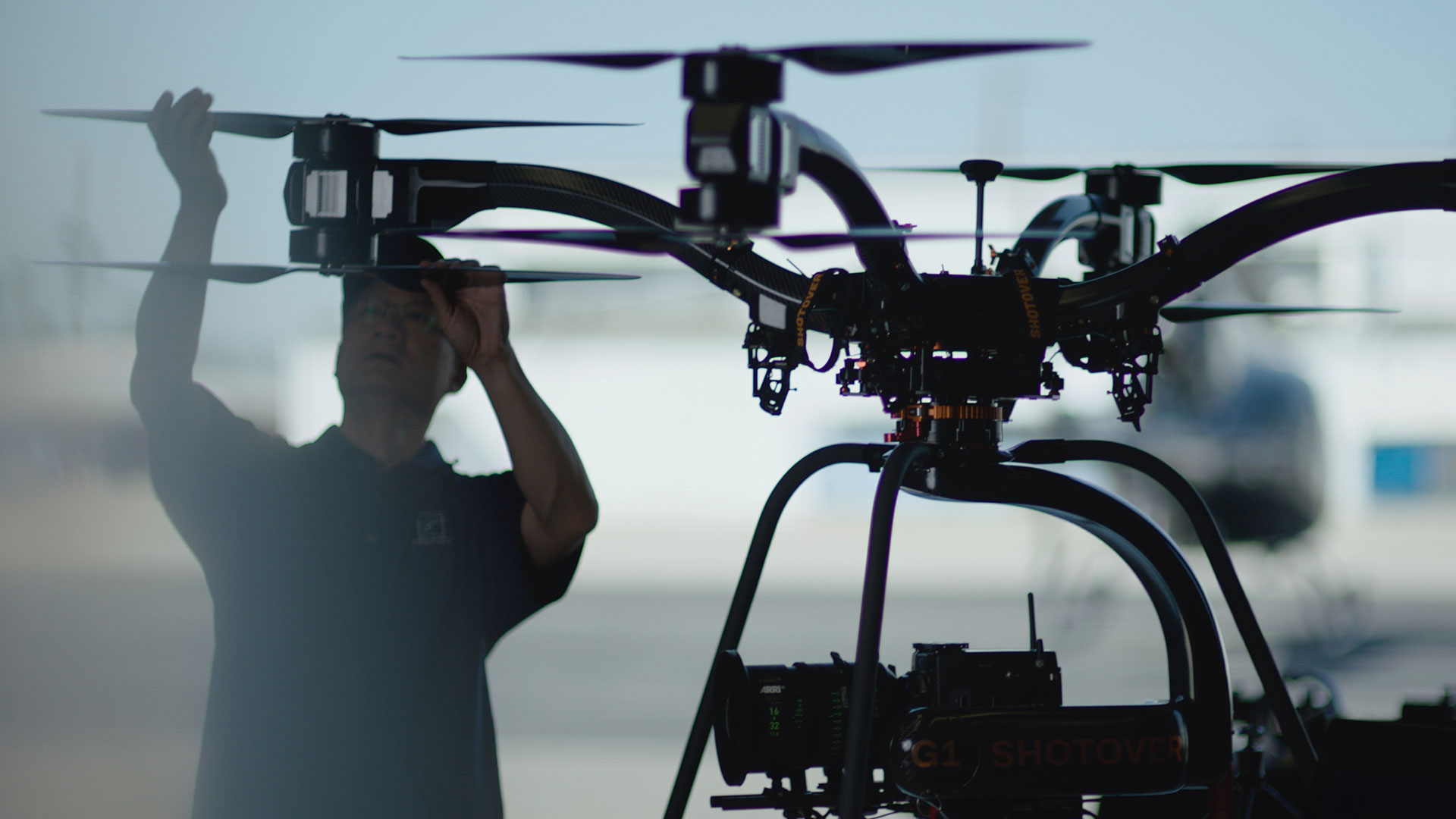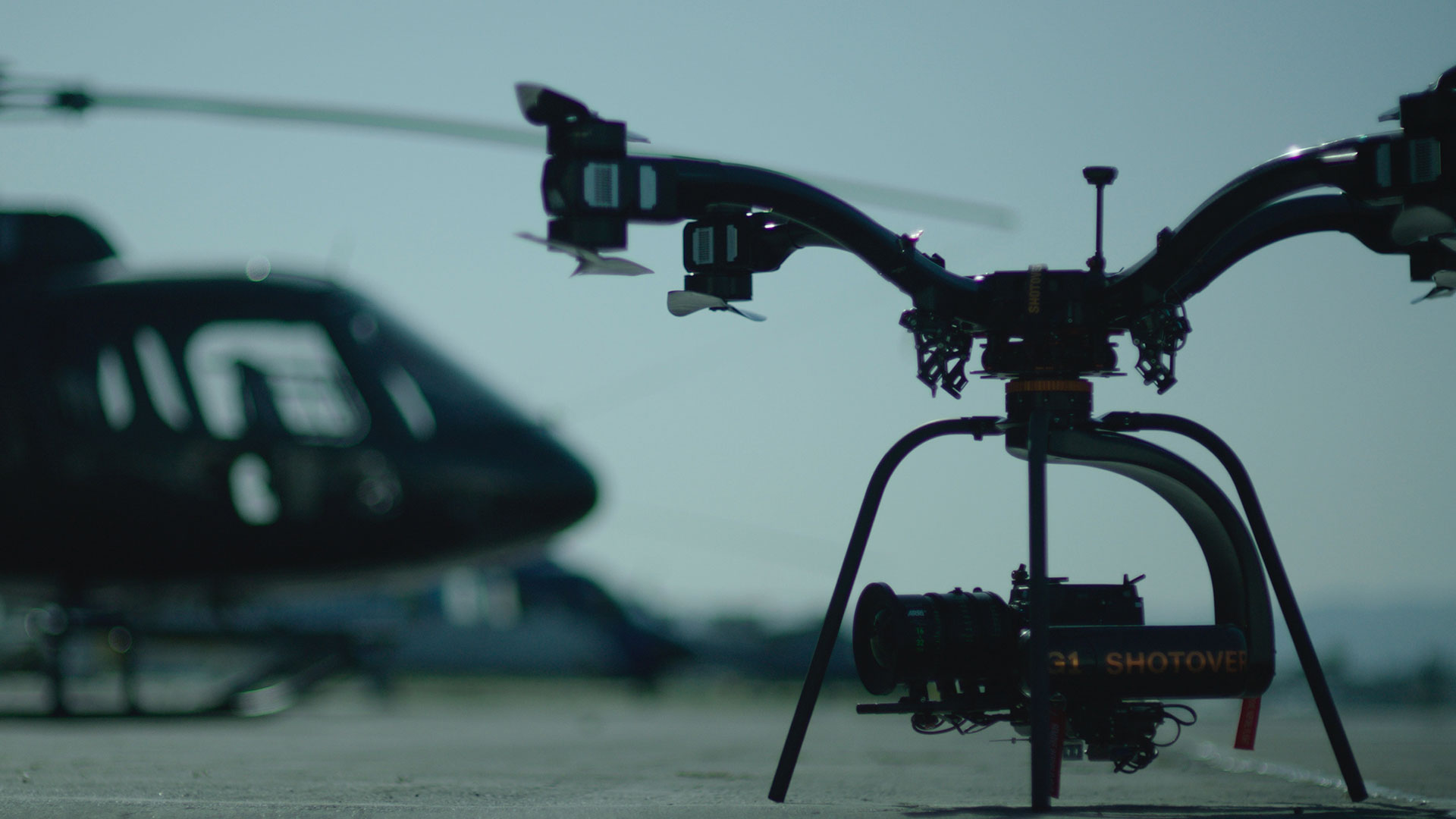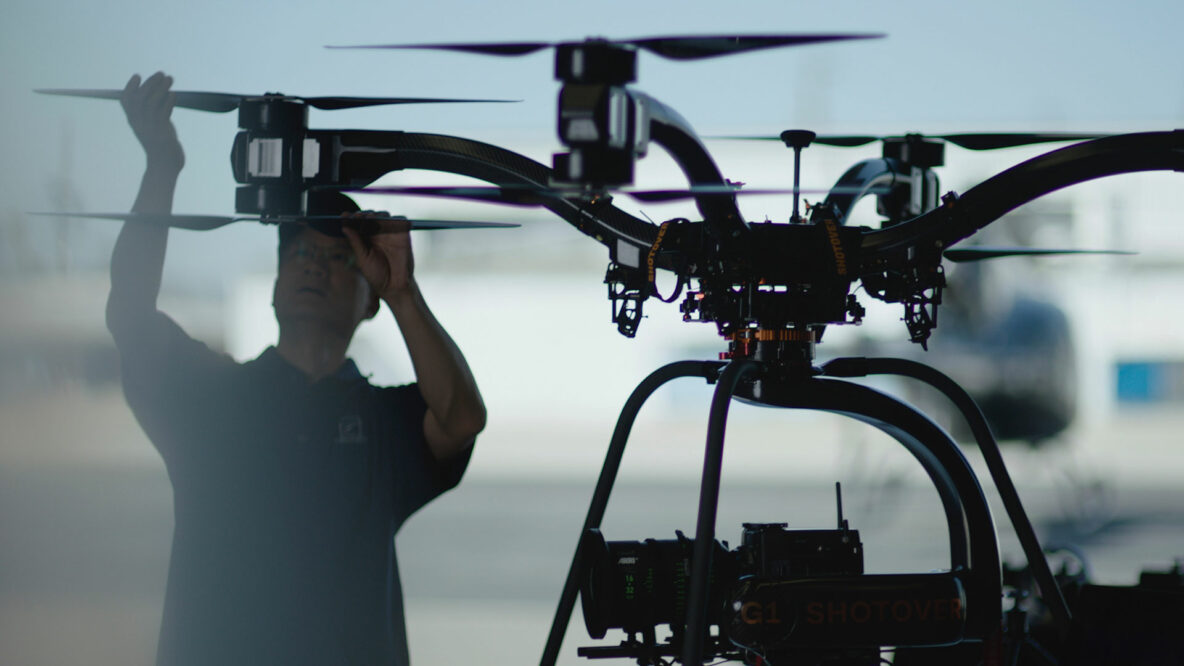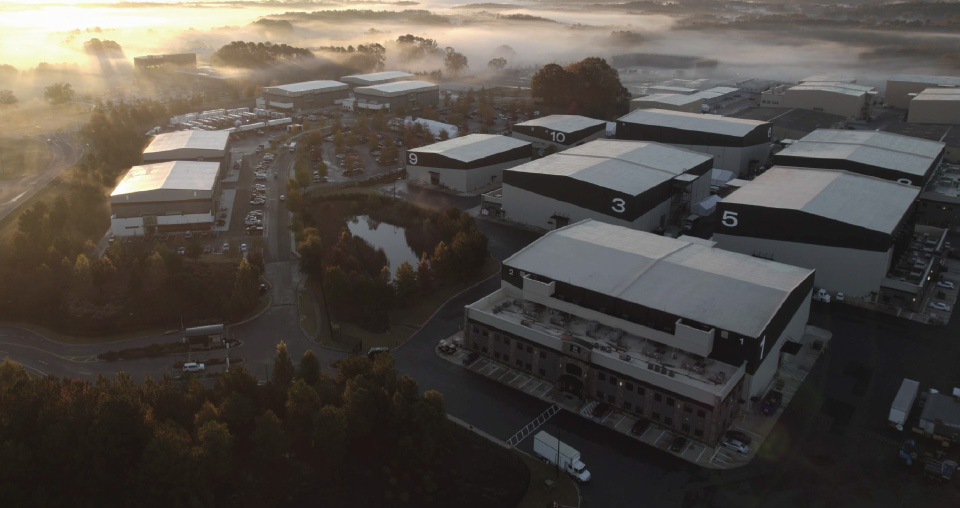"Precise timing and coordination are vital to make sure the drone works in harmony with other production elements."
By Carol Badaracco Padgett
In a moody scene from Ozark, Wendy Byrde (Laura Linney) stands outside the family’s home on the shores of the Lake of the Ozarks in Missouri, which is actually shot at Lake Lanier. As she stares at her son, Jonah (Skylar Gaertner), the tense conversation is artfully captured—drone hovering shoulder-level and within arm’s reach of the actors—by seasoned FAA drone pilot and cinematographer Jon Swindall.
“It’s pretty cool that during intense action sequences or chase scenes we can fly close to the action and post can paint out the drone from other angles,” Swindall shares. “In [these] shoots, precise timing and coordination are vital to make sure the drone works in harmony with other production elements.”

Victor Lee sets up for a shot

In the end, exquisite cinema drone piloting is an art.
Swindall puts it like this: “Being a drone pilot is all about expressing your artistry and craft. Just as a painter selects colors and brushes to convey emotions, I choose the perfect lens, flight path, camera movements and framing to tell a compelling story.”
In Swindall’s mind, the tight teamwork that’s necessary to capture the most amazing cinematic moments is a jewel of the job. “What truly excites me is collaborating with other creative minds, combining their unique ideas with my drone expertise, and bringing our vision to life.”
Twenty-five-year veteran pilot Wayne Mann, owner of Helicam Aerial Media Services LLC in Oxford, Georgia, says a cinema drone pilot’s communication skills must be top flight so they can interface well with directors and directors of photography (DPs), in particular.
“The feeling you get when the DP or director tells you what a great job you did is what [motivates me] to keep pushing to improve my skills and creative thinking,” Mann states.
But the most important capability a drone pilot brings to the set is obvious, he says: excellent piloting skills.
“It takes years of hard work to build the skill sets required to be a great pilot,” Mann stresses.
Top physical and mental conditioning are critical attributes in the toolkit, too.
“Good drone pilots have the ability to stay focused, pay attention to details, and have sharp eyesight,” Swindall describes. “They also need quick reflexes, perform well under pressure, stay organized, and have a knack for recognizing objects in space.”
For Swindall, professional cinema drone pilots are a bit like daredevils with a practical side.
Photo credit: Andrew Kommers
So Close to Reality
Victor Lee, technology director with 30-year-old film industry support company Helinet Aviation Services, lends the perspective of a tech expert who helps outfit film productions and their drone pilots with the tools and services, including helicopters, they need to get the shot.
“We’ll put cameras on anything that moves,” Lee says. “Boats, cars, aircraft … but we’re specialists in aviation.”
Lee adds to Swindall’s and Mann’s lists of critical skills that cinema drone pilots must bring to productions, beyond the FAA certifications and hours of training and flying.
“The skill set they must develop and possess is a phenomenon called control reversal,” notes Lee. “A traditional pilot with a manned aircraft [handles] control inputs as if they’re in a pilot’s seat or a captain’s chair. And this is not necessarily the case with a drone pilot.”
To expand on Lee’s point, a drone pilot can fly one of two ways: with a first-person view using a headset (known as FPV) and by line-of-sight—actually maintaining visuals with the aircraft. If the drone reverses 180 degrees while flying line-of-sight, the control reversal phenomenon must kick in for the pilot, and they must then use the controls in reverse.
"Normal pilots will never train for this."
- Victor Lee
The Drone Pilot
“Normal pilots will never train for this,” Lee states.
Of the dizzying number of capabilities a drone pilot must cultivate, there’s another that ordinary pilots don’t have to consider: story.
For Lee, “Really, it is story that drives the movement of the camera. And it’s dependent on the director’s vision.”
The director’s vision may be expressed in advance, or it may be something that pilots are only privy to on the day of the shoot.
“The availability of information varies from project to project,” Swindall describes. “Sometimes we’re provided with extensive details, while other times we [have to] actively seek out information and ask questions.”
As part of a drone team, the pilot shares, “we take on the responsibility of figuring out logistics and being in the right place at the right time. It’s a dynamic process that demands adaptability, production savvy and quick decision-making skills.”
On Swindall’s projects—series Ozark, The Resident, Love Is Blind, and others—his job often happens on the fly.
“It’s ‘prepare for anything and everything,’” Swindall describes. “For instance, in a past Marvel movie, I played a key role in drone location scouting, with weeks and weeks in advance, meticulously documenting details and creating flight plans for capturing specific shots.”
And yet, a call sheet with a one liner and a description of the action may be all the pilot gets.
“Drones are so commonplace now that we don’t get invited to production meetings, and oftentimes, before we are on set, we collaborate with the locations department about permissions and flight path and where we want to take off and land, and that’s about it,” Swindall shares. “And then you usually get information [about shots] from the director and the DP on the day before they do their first teamwork. In cases where we’re on standby, we must be close and ready to fly.”
Jon Swindall Reel
Swindall’s work on Ozark provides a great example of the kind of flexibility and adaptability that are critical for a drone pilot.
“… on Ozark, I frequently received notice just a day before shooting. [We’d] arrive in the morning, walk through drone shots for the day, plan the day, rehearse, and then get ready for intense, focused rounds of scene shooting,” he says.
Sometimes, Swindall got the green light to improvise.
“There are instances where complex scenes are happening and we’ve been given freedom to adapt to the situation, like jazz,” the pilot notes.
Keep in mind that all during production, pilots are also at the mercy of the elements.
“It’s not just about the drone in flight, but also about anticipating and interpreting the weather conditions and planning for the perfect lighting and wind conditions,” Swindall describes. “It’s a balance between nature’s elements, artistic instincts, and technical skill.”
Today, while many in the industry and everyplace else are balking at AI, pilots Swindall and Mann see its upside.
For Mann, “Progress and change is unavoidable, so you have to embrace it and work with it to stay on top in this industry.”
Swindall notes, “AI has already made the drone industry much safer in the last couple of years, with the ever-increasing ability to see and avoid obstacles autonomously, reducing the risk of flying on set.”
"There are instances where complex scenes are happening and we’ve been given freedom to adapt to the situation, like jazz."
- Drone Pilot
Photos Courtesy of Helinet. Credit: Andrew Kommers
Artificial Intelligence
AI is also helping drone pilots create never-before-seen shots.
“It can assist in automating flight paths, allowing drones to capture extremely precise programmable shots with little human intervention,” Swindall describes. “And it can also aid in real-time object tracking and framing, getting smooth and accurate subject tracking when the drone is in the air.”
In fact, as drone technology advances, the need for a separate camera operator and pilot is diminishing, Swindle finds. And soon, under certain scenarios, one person on set will be able to handle cameras on the ground and those in flight simultaneously.
However the technology develops, at the end of the day, a drone pilot’s work requires striking a balance between artistic instincts, nature’s elements, technical skill, the ability to maintain a razor-sharp focus, and the ability to work under intense pressure.
And through it all, Swindall says this simple skill is key: staying calm and friendly, even in challenging situations.
The daredevil should know; his drones have hovered within inches of Wendy Byrde.


